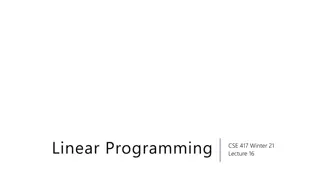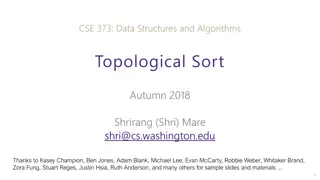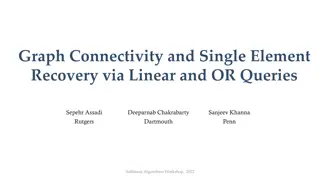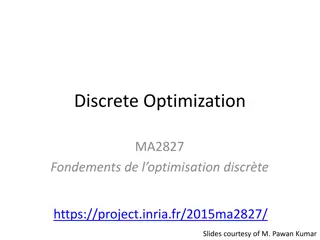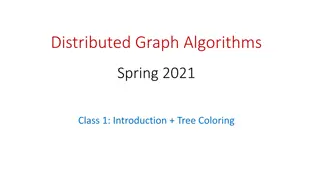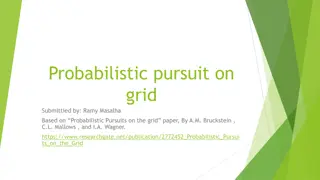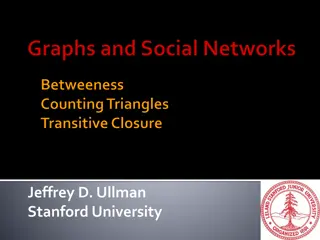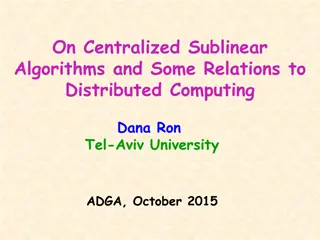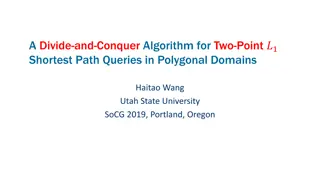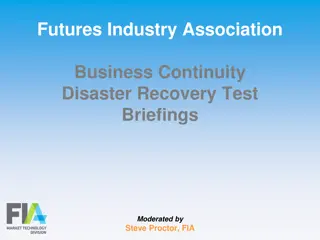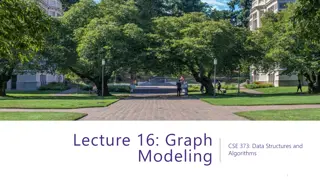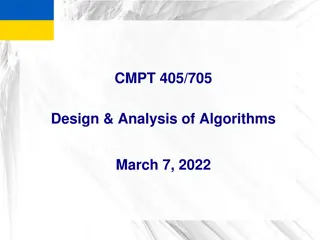Understanding Graph Algorithms for Connectivity and Shortest Paths
Graph algorithms play a crucial role in solving problems represented as networks, maps, paths, plans, and resource flow. This content delves into ways to find connectivity in graphs and algorithms for determining shortest paths. It discusses graph representations using adjacency matrices and lists, highlighting their space complexities and time complexities for various operations. Understanding these concepts is vital for efficient graph traversals and computations.
Download Presentation

Please find below an Image/Link to download the presentation.
The content on the website is provided AS IS for your information and personal use only. It may not be sold, licensed, or shared on other websites without obtaining consent from the author. Download presentation by click this link. If you encounter any issues during the download, it is possible that the publisher has removed the file from their server.
E N D
Presentation Transcript
Graph Algorithms Many problems are naturally represented as graphs Networks, Maps, Paths, Plans, Resource Flow, etc. Ch. 3 focuses on algorithms to find connectivity in graphs Ch. 4 focuses on algorithms to find shortest paths within graphs G = (V,E) V is a set of vertices (nodes) E is a set of edges between vertices, can be directed or undirected Undirected: e = {x,y} Directed: e = (x,y) Degree of a node is the number of impinging edges Nodes in a directed graph have an in-degree and an out-degree WWW is a graph Directed or undirected? CS 312 Graph Algorithms 1
Adjacency Matrix vs Adjacency List Two common ways to represent graphs in computers Directed versions Space complexity? Use V and E rather than n What is the time complexity to return if there is an edge between two nodes? Which representation is best? CS 312 Graph Algorithms 2
Graph Representation Adjacency Matrix n = |V| for vertices v1, v2, , vn Space complexity of adjacency matrix A is |V| |V| with 1 if there is an edge from vi to vj 0 otherwise aij= A is symmetric if it is undirected O(1) lookup to see if an edge exists between nodes |V|2 size is wasteful if A is sparse (i.e. not highly connected) If densely connected then |E| |V|2 so not wasteful in that case CS 312 Graph Algorithms 3
Graph Representation Adjacency List Adjacency List: V lists, one for each vertex Linked list for a vertex u contains the vertices to which u has an outgoing edge For directed graphs each edge appears in just one list For undirected graph each edge appears in both vertex lists Size is O(|V|+|E|) Worse case is if graph is dense. Then it is |V| 2 Note we usually only choose list if |E| is much less than |V|2 For directed graphs each edge appears in just one list Finding if two vertices are directly connected is no longer constant time CS 312 Graph Algorithms 4
Graph Representation Adjacency List Finding if two vertices are directly connected is no longer constant time (|V| for dense networks) For sparser networks it is just the avg outdegree of nodes, and is constant time if using hashing or if there is a max outdegree Worst case is |V| if highly connected in which case we would probably use and adjacency matrix Which representation is best? Depends on type of graph applications If dense connectivity, Matrix is usually best If sparse, then List is usually best Note that most large real world graph applications are sparse CS 312 Graph Algorithms 5
Depth-First Search (DFS) of Graphs What parts of the graph are reachable from a given vertex Reachable if there is a path between the vertices Note that in our 2 representations the computer only knows which are the neighbors of a specific vertex Deciding reachability is like exploring a labyrinth If we are not careful, we could miss paths, explore paths more than once, etc. What algorithm do you use if you are at a cave entrance and want to find a cave exit on the other side? Depth first search works Chalk (to avoid loops) and string to return to previous fork For DFS visited(v)=true will be our chalk and recursive stack our string CS 312 Graph Algorithms 6
Explore Procedure Algorithm to find which nodes are reachable from an initial node v works for both directed and undirected graphs previsit(v) and postvisit(v) are optional updating procedures Complexity? CS 312 Graph Algorithms 7
Explore Procedure Algorithm to find which nodes are reachable from an initial node v works for both directed and undirected graphs previsit(v) and postvisit(v) are optional updating procedures Complexity Each reachable edge er checked exactly once (twice if undirected) O(|Er|) = O(|E|) CS 312 Graph Algorithms 8
Data Structures Matter Explore is O(|E|) (linear in number of edges) if using adjacency list but is O(|V|2) if using adjacency matrix. Why? If the graph is dense then matrix is reasonable since in that case |E| |V|2 anyways CS 312 Graph Algorithms 9
Visiting Entire Graph - DFS An undirected graph is connected if there is a path between any pair of nodes Otherwise the graph is made up of disjoint connected components Visiting entire graph is O(|?|) CS 312 Graph Algorithms 10
Visiting Entire Graph - DFS An undirected graph is connected if there is a path between any pair of nodes Otherwise the graph is made up of disjoint connected components Visiting entire graph is O(|V| + |E|) Note this is the amount of time it would take just to scan through the adjacency list Why isn t it O(|V| |E|) ? Why not just say O(|E|) since |V| is usually smaller than |E|? Space complexity is that of graph representation (|V| + |E| for list, |V|2 for matrix) What do we accomplish by visiting entire graph? CS 312 Graph Algorithms 11
Previsit and Postvisit Orderings Each pre and post visit is an ordered event Account for all edges Tree edges (solid: actually traversed with explore) and Back edges (dashed: looking down edge reveals a node already visited) 12
Previsit and Postvisit Orders DFS yields a forest (disjoint trees) when there are disjoint components in the graph Can use pre/post visit numbers to detect properties of graphs Account for all edges: Tree edges (solid) and back edges (dashed) Back edges detect cycles Uniquely label each connected component Properties still there even if explored in a different order (i.e. start with F, then J) 13
**Challenge Question** Draw DFS forest with Pre/Post orderings and connected component id Decide amongst options reverse alphabetically 14 Account for all edges Tree edges and Back edges
Depth-First Search in Directed Graphs Can use the same DFS algorithm as before, but only traverse edges in the prescribed direction Thus, each edge just considered once (not twice like undirected) Introduces two new types of dashed edges Cross edges lead to neither descendant nor ancestor in DFS tree Forward edges lead from a node to a nonchild descendant Note ancestor relationships are part of DFS tree, not original graph CS 312 Graph Algorithms 15
Depth-First Search in Directed Graphs Tree edges and back edges (2 below) the same as before Added terminology for DFS Tree of a directed graph Forward edges lead from a node to a nonchild descendant (2 below) Cross edges lead to neither descendant or ancestor, lead to a node which has already had its postvisit (2 below) CS 312 Graph Algorithms 16
Back Edge Detection Edge types can be read off directly from pre and post numbers of the DFS tree just check nodes connected by each edge In this chart initial node of edge is u and final node is v Tree/forward reads pre(u) < pre(v) < post(v) < post(u) CS 312 Graph Algorithms 17
DAG Directed Acyclic Graph DAG a directed graph with no cycles Very common in applications Ordering of a set of tasks. Must finish pre-tasks before another task can be done How do we test if a directed graph is acyclic in linear time? CS 312 Graph Algorithms 18
DAG Directed Acyclic Graph DAG a directed graph with no cycles Very common in applications Ordering of a set of tasks. Must finish pre-tasks before another task can be done How do we test if a directed graph is acyclic in linear time? Property: A directed graph has a cycle iff DFS reveals a back edge Just do DFS and see if there are any back edges How do we check after running DFS for back edges and what is complexity? CS 312 Graph Algorithms 19
DAG Directed Acyclic Graph DAG a directed graph with no cycles Very common in applications Ordering of a set of tasks. Must finish pre-tasks before another task can be done How do we test if a directed graph is acyclic in linear time? Property: A directed graph has a cycle iff DFS reveals a back edge Just do DFS and see if there are any back edges How do we check after running DFS for back edges and what is complexity? O(|E|) for each edge check pre/post values of nodes Could test while building the DFS tree and stop early CS 312 Graph Algorithms 20
DAG Properties Every DAG can be linearized More than one linearization usually possible CS 312 Graph Algorithms 21
DAG Properties Every DAG can be linearized More than one linearization usually possible Algorithm to linearize Property: In a DAG, every edge leads to a node with lower post number Do DFS, then linearize by choosing nodes by decreasing post number Other linearizations usually possible Sort by posts after? Which node do we start DFS at? Makes no difference, B will always have largest post (Try A and F) CS 312 Graph Algorithms 22
DAG Properties Every DAG can be linearized More than one linearization usually possible Algorithm to linearize Property: In a DAG, every edge leads to a node with lower post number Do DFS, then linearize by choosing nodes by decreasing post number Other linearizations usually possible Sort by posts after? Which node do we start DFS at? Makes no difference, B will always have largest post (Try A and F) Another property: Every DAG has at least one source and at least one sink Source has no input edges If multiple sources, linearization can start with any of them Sink has no output edges Is the above directed graph connected? CS 312 Graph Algorithms 23
DAG Properties With directed graphs, strongly connected means every node has a path to every other node (same as connected for undirected graphs) Is the above directed graph strongly connected? It would be if it were undirected o A directed graph is weakly connected if it would be connected if the edges were undirected A DAG is never a strongly connected graph, since there would be a cycle CS 312 Graph Algorithms 24
Strongly Connected Components Two nodes u and v in a directed graph (digraph) are (strongly) connected if there is a path from u to v and a path from v to u The disjoint subsets of a directed graph which are strongly connected are called strongly connected components How could we make the entire graph strongly connected? CS 312 Graph Algorithms 25
Meta-Graphs EVERY directed graph is a DAG of its strongly connected components This meta-graph decomposition is very useful in many applications (e.g. a high level flow of the task with subtasks abstracted) CS 312 Graph Algorithms 26
Algorithm to Decompose a Directed Graph into its Strongly Connected Components explore(G,v) terminates precisely when all nodes reachable from v have been visited If we could pick any v from any sink meta-node, then call explore. It would explore that complete SCC, marking all nodes in it as a SCC, and not reach any other nodes Then remove SCC from the graph (or just use visited flags), and repeat How do we detect if a node is in a meta-sink? In DAG a source node will have the highest post and a sink the lowest How about starting from the node with the lowest post-visit value Doesn't work with arbitrary graphs (with cycles) which are what we are dealing with. B below could have a lower post order than C even though it is not a sink A B C CS 312 Graph Algorithms 27
Algorithm to Decompose a Directed Graph into its Strongly Connected Components How do we detect if a node is in a meta-sink? Property: Node with the highest post order in a DFS search must lie in a source SCC Just temporarily reverse the edges in the graph and do a DFS on GR to get post ordering Then node with highest post in DFS of GR, which will be in a source SCC of GR, must be in a sink SCC in G Repeat until graph is empty: Choose the node with the highest remaining post score from DFS on GR. In G explore that node and mark/prune the SCC in G. CS 312 Graph Algorithms 28
Example Create GR by reversing graph G Do DFS on GR Repeat until graph G is empty: Choose the node with the highest remaining post score from DFS on GR. In G explore that node and mark/prune the SCC in G. G GR CS 312 Graph Algorithms
**Challenge Question** Complexity We know complexity of DFS is linear O(|V| + |E|) Is our new algorithm still linear? Only if our new requirements are linear Order vertices of GR by decreasing post values Create GR Propose a linear time method for each of these when using an adjacency list Think about how you would handle the reversal if using an adjacency matrix, which we would use if the graph is dense (i.e. |E| |V|2) G GR CS 312 Graph Algorithms
**Challenge Question** Complexity We know complexity of DFS is linear - O(|V| + |E|) Is our new algorithm still linear? Only if our new requirements are linear. Order vertices of GR by decreasing post values Create postorder ranked list as you do DFS just like for linearization. After each sink SCC removal, scan down the list to the next unvisited node. Total O(V). Create GR Adjacency List: Creating adjacency list GR is O(|V| + |E|) Create new list as follows. For each edge (x,y) in G adjacency list, append x to the endof GRy list (initially empty). To avoid traversing GRy list each time maintain a pointer to the current end of each GRy list during creation. Adjacency Matrix: Could just create a new GR matrix by setting A[i,j] in GR to A[j,i] in G matrix, but that is V2 time (all right since DFS is V2 anyways with dense matrix). Faster to just use the original G matrix and whenever we would look up A[i,j] during GR DFS, use A[j,i] instead. CS 312 Graph Algorithms
Graph Connectedness Conclusion By doing one linear time, O(|V|+|E|), depth-first search (DFS), we can efficiently gather lots of important information about arbitrary undirected or directed graphs Cycles Connectivity Finding and labeling Connected Components Finding and labeling Strongly Connected Components Linearizations Finding source and sink nodes and meta-nodes etc. CS 312 Graph Algorithms 32





